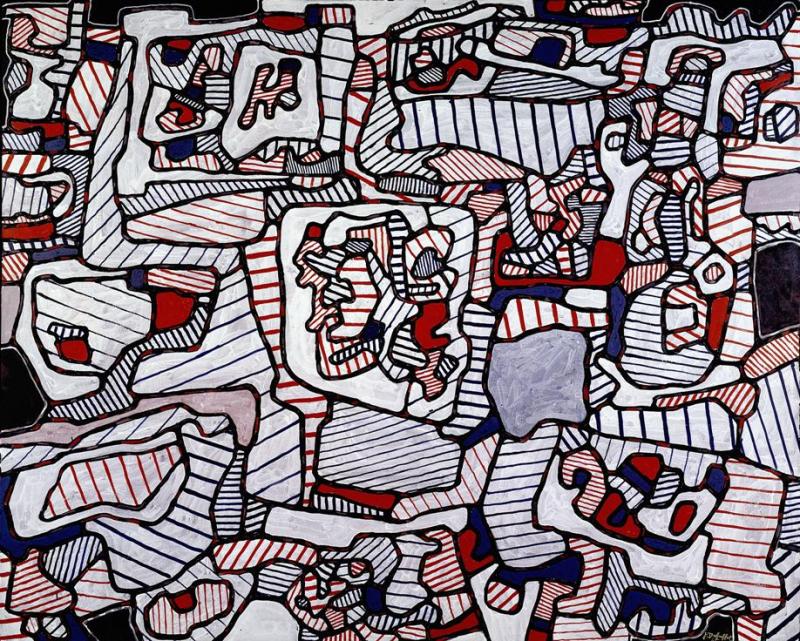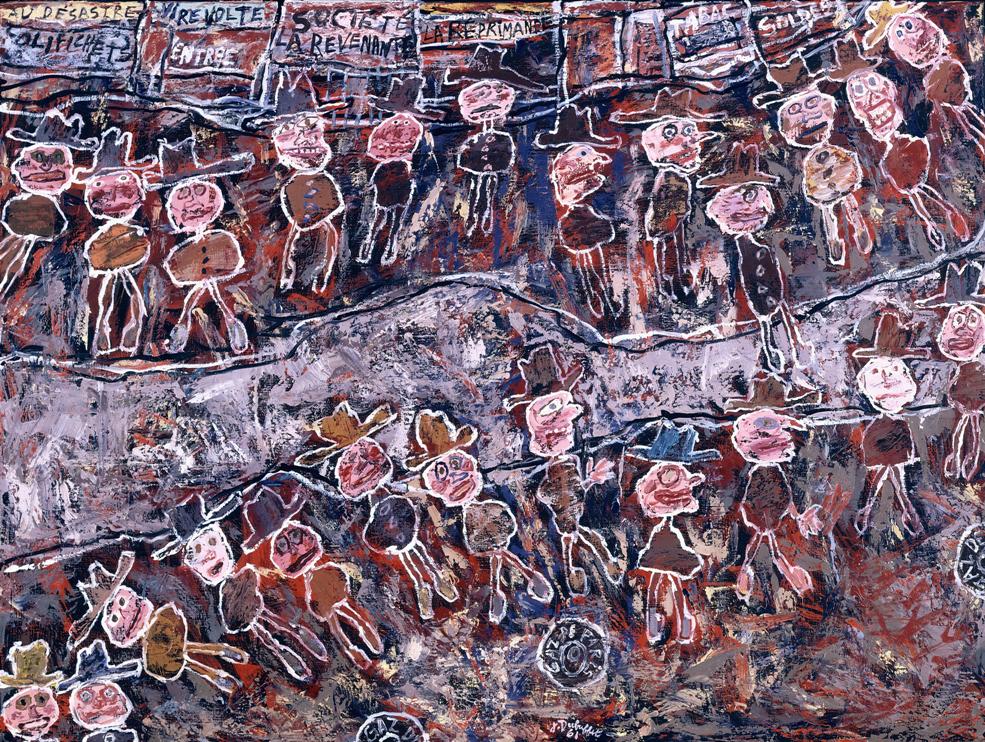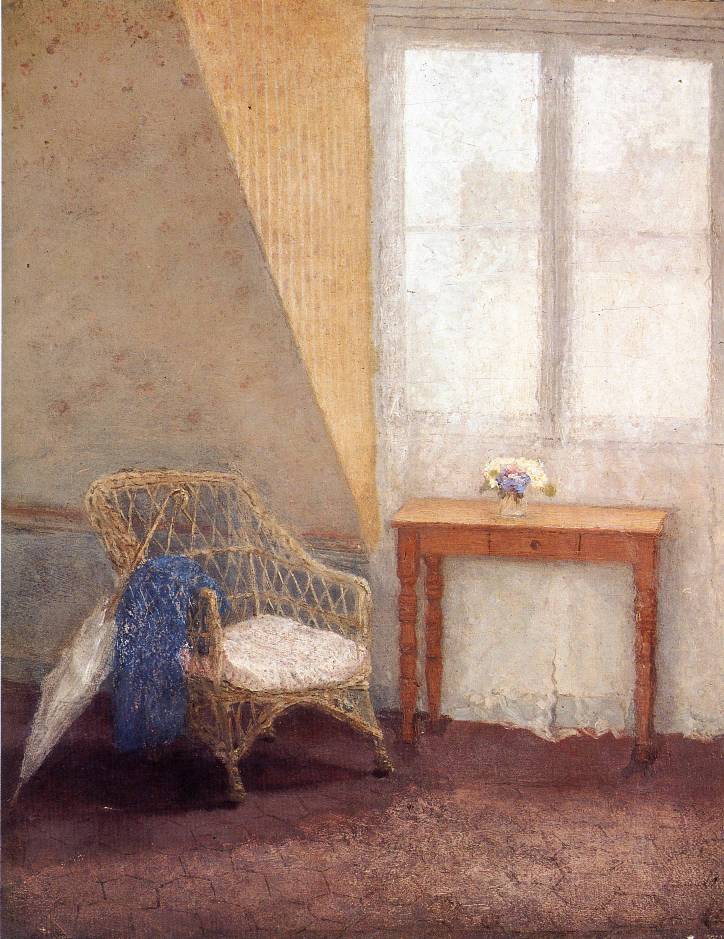Jean Dubuffet/ Gwen John and Celia Paul, Pallant House Gallery, Chichester | reviews, news & interviews
Jean Dubuffet/ Gwen John and Celia Paul, Pallant House Gallery, Chichester
Jean Dubuffet/ Gwen John and Celia Paul, Pallant House Gallery, Chichester
Raw art from the 1960s, and two reclusive female painters compared

Pallant House Gallery is an extraordinary hybrid, an elaborate and magnificent early 18th-century town house on a narrow Chichester street in the heart of the city, with a soberly elegant extension by Colin St John Wilson (2006) which houses one of the finest collections of 20th-century British art anywhere in the country. Nothing could be more powerful and intelligently surprising than its present unusual combination of shows.
Several first-floor galleries are filled with a substantial showing of work from the 1960s of that art brut – raw art - pioneer Jean Dubuffet (1901-1985): characteristic constructions, paintings and drawings in his obsessive abstract imagery, like huge doodles writ large over writhing surfaces. Dubuffet scorned what he saw as pretentious, knowing, self-conscious, “educated” art, and became obsessed as both an admirer and collector by non-professional, self-taught artists, “unscathed by artistic culture”. As Dubuffet put it himself, “What I expect from any work of art is that it surprises me, that it violates my customary valuations of things and offers me other, unexpected ones".
 He broke down barriers between accepted canons of ugliness and beauty, which of course presents the paradox, visible at Pallant House, that his very tough art is not beguiling or alluring in conventional ways, but memorable and even mesmerising; he deliberately questions any classical notion of beauty. The purpose of art is to provoke and shock, he suggested by both statement and practice; “art speaks to the mind and not to the eye.” But Dubuffet makes sure the eye is drawn in, and cannot escape the characteristic impact made by his work. (Pictured right: Solario (portrait), 1967.)
He broke down barriers between accepted canons of ugliness and beauty, which of course presents the paradox, visible at Pallant House, that his very tough art is not beguiling or alluring in conventional ways, but memorable and even mesmerising; he deliberately questions any classical notion of beauty. The purpose of art is to provoke and shock, he suggested by both statement and practice; “art speaks to the mind and not to the eye.” But Dubuffet makes sure the eye is drawn in, and cannot escape the characteristic impact made by his work. (Pictured right: Solario (portrait), 1967.)
His own trajectory was deliberately complex: coming from Le Havre, he spent years in Paris, some months in formal study but mostly immersed in intensive forays into philosophy and music, painting, languages and classics. He was much travelled, worked as an industrial draughtsman, and spent years in his family’s wine business, only returning permanently and irrevocably to art in his forties. His work soon infiltrated the world of museums and galleries. There is many a public installation, as he made large works of polyester resin painted in his characteristic patterns of restricted colours, so large that they can be walked into.
On view here is a variety of wall-hanging paintings and three-dimensional sculptures, amounting to a mini-journey through his art. Much is black, white, red and blue in a cascade of colour blocks and lines, like frenzied cellular structures seen in brilliant primary colour. The materials are diverse: paint can be vinyl, acrylic, oil. The patterns are both crazy and rational, and the figures which emerge may be poignant, childish, chaotic, affecting, touching or frightening. Dubuffet, like Picasso, has made mainstream a deliberate and knowing, yet artless, direct and seemingly spontaneous childishness. His intensely original imagination is evident in his whirligig Site Inhabited by Objects, 1961 (main image): now you see them now you don’t.
 Spinning Round (pictured left) shows two crowds of rather sadly forlorn figures, huddled in various stages of desolation, perhaps anger too, separated by a greyish river or boundary. The dark Inhabited Landscape is certainly not a landscape much enjoyed by its inhabitants; it is also difficult to discern exactly what is happening in Nimble Free Hand to the Rescue, but perhaps the cheerily grotesque figures in Dubuffet’s characteristic palette are up to something good. He was indeed a puppeteer, creating figures called Hourloupes, meaning outsiders. More nightmare than dream, Dubuffet remains enigmatically powerful, pushing us in directions we might not want to take, showing us things we might not want to see, but somehow in his opulent astringency convincing us that these are worlds we ought to know about.
Spinning Round (pictured left) shows two crowds of rather sadly forlorn figures, huddled in various stages of desolation, perhaps anger too, separated by a greyish river or boundary. The dark Inhabited Landscape is certainly not a landscape much enjoyed by its inhabitants; it is also difficult to discern exactly what is happening in Nimble Free Hand to the Rescue, but perhaps the cheerily grotesque figures in Dubuffet’s characteristic palette are up to something good. He was indeed a puppeteer, creating figures called Hourloupes, meaning outsiders. More nightmare than dream, Dubuffet remains enigmatically powerful, pushing us in directions we might not want to take, showing us things we might not want to see, but somehow in his opulent astringency convincing us that these are worlds we ought to know about.
 The paintings, prints and drawings by Gwen John (1876-1939) and Celia Paul (b 1959) offer the delicate, highly personal art of two reclusive and obsessive female artists, separated by a century. Each was muse, model and lover to powerful male artists, Gwen John giving herself over to Rodin, and Celia Paul, for a formative period, to Lucian Freud. In the latter case it is probable that muse-dom was reciprocal in the powerfully melancholy figuration of Paul’s portraits.
The paintings, prints and drawings by Gwen John (1876-1939) and Celia Paul (b 1959) offer the delicate, highly personal art of two reclusive and obsessive female artists, separated by a century. Each was muse, model and lover to powerful male artists, Gwen John giving herself over to Rodin, and Celia Paul, for a formative period, to Lucian Freud. In the latter case it is probable that muse-dom was reciprocal in the powerfully melancholy figuration of Paul’s portraits.
Gwen John’s small Interior of the Artist’s Room in Paris (pictured right) is a tiny masterpiece: a chair, a parasol, a table, a small bunch of flowers, a view of a shadowy building from the garret window, through gauzy curtains, an unassuming tour de force of paint. She died of exhaustion and starvation, leaving behind a small but perfectly formed oeuvre of small-scale portraits, herself and others.
Celia Paul makes soft ground prints which are images of people and interiors that look as though they have just been whispered onto the paper, and paints the people in her circle of friends and relatives – notably her son with Freud, Frank, and her mother, her sisters – and pared down stark views of London landmarks, the Post Office Tower, a church spire – seen from her studio window. These are lonely artists, to some extent outside the conventional “isms” of art who nevertheless speak to a web of human connection.
- Jean Dubuffet at Pallant House Gallery until 3 February. Gwen John and Celia Paul at Pallant House Gallery until 27 January
Explore topics
Share this article
The future of Arts Journalism
You can stop theartsdesk.com closing!
We urgently need financing to survive. Our fundraising drive has thus far raised £49,000 but we need to reach £100,000 or we will be forced to close. Please contribute here: https://gofund.me/c3f6033d
And if you can forward this information to anyone who might assist, we’d be grateful.

Subscribe to theartsdesk.com
Thank you for continuing to read our work on theartsdesk.com. For unlimited access to every article in its entirety, including our archive of more than 15,000 pieces, we're asking for £5 per month or £40 per year. We feel it's a very good deal, and hope you do too.
To take a subscription now simply click here.
And if you're looking for that extra gift for a friend or family member, why not treat them to a theartsdesk.com gift subscription?
more Visual arts
 'We are bowled over!' Thank you for your messages of love and support
Much-appreciated words of commendation from readers and the cultural community
'We are bowled over!' Thank you for your messages of love and support
Much-appreciated words of commendation from readers and the cultural community
 Lee Miller, Tate Britain review - an extraordinary career that remains an enigma
Fashion photographer, artist or war reporter; will the real Lee Miller please step forward?
Lee Miller, Tate Britain review - an extraordinary career that remains an enigma
Fashion photographer, artist or war reporter; will the real Lee Miller please step forward?
 Kerry James Marshall: The Histories, Royal Academy review - a triumphant celebration of blackness
Room after room of glorious paintings
Kerry James Marshall: The Histories, Royal Academy review - a triumphant celebration of blackness
Room after room of glorious paintings
 Folkestone Triennial 2025 - landscape, seascape, art lovers' escape
Locally rooted festival brings home many but not all global concerns
Folkestone Triennial 2025 - landscape, seascape, art lovers' escape
Locally rooted festival brings home many but not all global concerns
 Sir Brian Clarke (1953-2025) - a personal tribute
Remembering an artist with a gift for the transcendent
Sir Brian Clarke (1953-2025) - a personal tribute
Remembering an artist with a gift for the transcendent
 Emily Kam Kngwarray, Tate Modern review - glimpses of another world
Pictures that are an affirmation of belonging
Emily Kam Kngwarray, Tate Modern review - glimpses of another world
Pictures that are an affirmation of belonging
 Kiefer / Van Gogh, Royal Academy review - a pairing of opposites
Small scale intensity meets large scale melodrama
Kiefer / Van Gogh, Royal Academy review - a pairing of opposites
Small scale intensity meets large scale melodrama
 Jenny Saville: The Anatomy of Painting, National Portrait Gallery review - a protégé losing her way
A brilliant painter in search of a worthwhile subject
Jenny Saville: The Anatomy of Painting, National Portrait Gallery review - a protégé losing her way
A brilliant painter in search of a worthwhile subject
 Abstract Erotic, Courtauld Gallery review - sculpture that is sensuous, funny and subversive
Testing the boundaries of good taste, and winning
Abstract Erotic, Courtauld Gallery review - sculpture that is sensuous, funny and subversive
Testing the boundaries of good taste, and winning
 Edward Burra, Tate Britain review - watercolour made mainstream
Social satire with a nasty bite
Edward Burra, Tate Britain review - watercolour made mainstream
Social satire with a nasty bite
 Ithell Colquhoun, Tate Britain review - revelations of a weird and wonderful world
Emanations from the unconscious
Ithell Colquhoun, Tate Britain review - revelations of a weird and wonderful world
Emanations from the unconscious
 Rachel Jones: Gated Canyons, Dulwich Picture Gallery review - teeth with a real bite
Mouths have never looked so good
Rachel Jones: Gated Canyons, Dulwich Picture Gallery review - teeth with a real bite
Mouths have never looked so good

Add comment